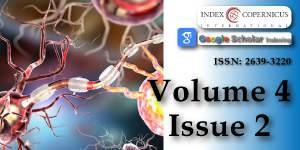Post-stroke dizziness of visual-vestibular cortices origin
Main Article Content
Abstract
Many patients with chronic cerebrovascular diseases complain “dizziness”, which is a distortion of static gravitational orientation, or an erroneous perception of motion of the sufferer or of the environment. In the vestibular cortical system, the parieto-insular vestibular cortex (PIVC) serves as the core region having the strong interconnections with other vestibular cortical areas and the vestibular brainstem nuclei. By forming the reciprocal inhibitory interactions with the visual cortex (VISC), it also plays a pivotal role in a multisensory mechanism for self-motion perception. In a line of our studies on post-stroke patients, we found that there was a significant decrease in the cerebral blood flow in both the VISC and PIVC in the patients who suffered from dizziness. In this article, we provide a new concept that due to dysfunction of the visual-vestibular interaction loop, low cerebral blood perfusion in the PIVC and VISC might elicit post-stroke dizziness.
Article Details
Copyright (c) 2020 Inoue N, et al.

This work is licensed under a Creative Commons Attribution 4.0 International License.
Leigh RJ, Zee DS. The Neurology of Eye Movements. New York: Oxford University Press 1999.
Baloh RW. The dizzy patient. Postgrad Med. 1999; 105: 161-164. PubMed: https://pubmed.ncbi.nlm.nih.gov/10026710/
Tusa RJ. Dizziness. Med Clin North Amer. 2003; 87: 609-641. PubMed: https://pubmed.ncbi.nlm.nih.gov/12812406/
Brandt T, Strupp M. General vestibular testing. Clin Neurophysiol. 2005; 116: 406-426. PubMed: https://pubmed.ncbi.nlm.nih.gov/15661119/
Burt CW, Schapper SM. Ambulatory care visits to physician offices, hospital out-patient departments, and emergency departments. United States, 1999-2000. Vital Health Stats. 2004; 13: 161-714.
Kerber KA, Brown D, Lisabeth, LD, Smith MA, Morgenstern JB. Stroke among patients with dizziness, vertigo, and imbalance in the emergency department. A population-based study. Stroke. 2006; 37: 2484-2487. PubMed: https://pubmed.ncbi.nlm.nih.gov/16946161/
Penfield W, Jasper H. Epilepsy and the Functional Anatomy of the Human Brain. 1954.
Grusser OJ, Pause M, Schreiter U. Neuronal response in the parieto-insular vestibular cortex of alert Java monkeys (Macaca fascicularis). (1990) In: Physiological and Pathological Aspects of Eye Movements. 251-270.
Gruccer OJ, Pause M, Schreuter U. Localization and responses of neurons in the parieto-insular vestibular cortex of awake monkeys (Macaca fascicularis). J Physiol. 1990; 430: 537-557. PubMed: https://pubmed.ncbi.nlm.nih.gov/2086773/
Guldin W, Grusser OJ. The anatomy of the vestibular cortices of primates. In: M. Collard, M. Jeannerord, Y. Christen (eds) Le cortex vestibulaire, Ipsen, Boulogne. 1996; 17-26.
Wenzel R, Bartenstein P, Dieterich M, Danek A, Weindl A, et al. Deactivation of human visual cortex during involuntary ocular oscillations: A PET activation study. Brain. 1996; 119: 101-110. PubMed: https://pubmed.ncbi.nlm.nih.gov/8624674/
Tiecks FP, Planck J, Harberl RL, Brandt T. Reduction in posterior cerebral artery blood flow velocity during caloric vestibular stimulation. J Cerebr Blood Flow Metab. 1996; 6: 1379-1382. PubMed: https://pubmed.ncbi.nlm.nih.gov/8898715/
Brandt T, Bucher SF, Seelos KC, Dieterich M. Reciprocal inhibitory visual-vestibular interaction: Visual motion stimulation deactivates the parieto-insular vestibular cortex. Brain. 1998; 121: 1749-1758. PubMed: https://pubmed.ncbi.nlm.nih.gov/9762962/
Ombergen AV, Heine L, Jillings S, Roberts RE, Jeurissen B, et al. Altered functional brain connectivity in patients with visually induced dizziness. NeuroImage: Clinical. 2017; 14: 538-545. PubMed: https://pubmed.ncbi.nlm.nih.gov/28331800/
Inoue N, Fuyuta S. Cerebral blood flow in the visual and parieto-insular vestibular cortices in the patients after cerebral ischemia with or without dizziness. Int J Neuro Disord Interv. 2015; 1: 101-104.
Inoue N, Harada M. Effect of ibudilast on non-specific symptoms in patients with chronic cerebral ischemia. Artzneimittelforschung. 2008; 58: 277-282. PubMed: https://pubmed.ncbi.nlm.nih.gov/18677969/
Inoue N, Fukuda S. Inada T. Sameshima E., Tokushima Y et al. Effect of ibudilast on the reciprocal inhibitory visual-vestibular interaction closely related to dizziness after cerebral ischemia. J Stroke Cerebrovasc Dis. 2014; 23: 51-55. PubMed: https://pubmed.ncbi.nlm.nih.gov/23085301/
Deutschlander A, Benses S, Stephan T, Schwaiger M, Brandt T et al. Sensory system interaction during simultaneous vestibular and visual stimulation in PET. Hum Brain Mapp. 2002; 16: 92-103. PubMed: https://pubmed.ncbi.nlm.nih.gov/11954059/
Naito Y, Tateya I, Hirano S, Inoue M, Funabiki K, et al. Cortical correlates of vestibulo-ocular reflex modulation: A PET study. Brain. 2003; 126: 1562-1578. PubMed: https://pubmed.ncbi.nlm.nih.gov/12805122/
Dieterich M, Bauerman T, Best C, Stoeter P, Schlindwein P. Evidence for cortical visual substitution of chronic bilateral vestibular failure (an fMRI study) Brain. 2007; 130: 2108-2116. PubMed: https://pubmed.ncbi.nlm.nih.gov/17575279/

